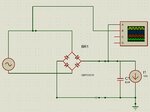paardenvlees
Newbie level 4
Hi,
I have an output with 230Vrms 50 Hz.
I want to put a diode bridge rectifier after it and then with an electronic load(2.3kW or 10A)
The used equations are from this page: https://www.electronics-tutorials.ws/diode/diode_6.html?utm_referrer=https://www.google.com/
The calculation of the rectifier max output is:
Vmax = Vrms * sqrt(2) - Vf
Vmax = 230* sqrt(2) - 1.1
Vmax = 324V
Vaverage = 2*Vmax /pi = 206V
capacitance = Iload/(Vrip*Hz) = 10/(5*50) = 0.04F
The system is simulated in proteus and i get a perfect 230V max voltage output.
Is the simulation just doing the most ideal or did i do some wrong calculations?
Further I am in doubt how to add the load to the system.
I can do constant power and constant current and constant resistance. I don't know what the best choice is in this situation.
Simulation setup:

I have an output with 230Vrms 50 Hz.
I want to put a diode bridge rectifier after it and then with an electronic load(2.3kW or 10A)
The used equations are from this page: https://www.electronics-tutorials.ws/diode/diode_6.html?utm_referrer=https://www.google.com/
The calculation of the rectifier max output is:
Vmax = Vrms * sqrt(2) - Vf
Vmax = 230* sqrt(2) - 1.1
Vmax = 324V
Vaverage = 2*Vmax /pi = 206V
capacitance = Iload/(Vrip*Hz) = 10/(5*50) = 0.04F
The system is simulated in proteus and i get a perfect 230V max voltage output.
Is the simulation just doing the most ideal or did i do some wrong calculations?
Further I am in doubt how to add the load to the system.
I can do constant power and constant current and constant resistance. I don't know what the best choice is in this situation.
Simulation setup:


